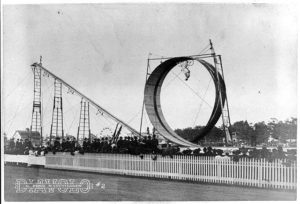Texas can claim its share of notable people—actors, artists, athletes, authors, philanthropists, political figures, singers, stars, and so on. It can also claim a master stuntman.
Today’s movie and stunt fans likely won’t remember the name Robert Vandervoort. He made his mark over a century ago, in an era before movies came into their own. But Vandervoort had a sense of vision and daring that propelled him to unprecedented heights in his day.
He grew up in Corpus Christi, moved in 1891 to New York, and became an electrician. He was 22 at the time.
In September, 1901, Vandervoort watched a stuntman attempt a loop-the-loop in Madison Square Garden in New York. The effort failed and the stuntman broke a leg. Vandervoort began thinking about how he could perform the loop-the-loop. He helped build a loop-the-loop that was 40’ in diameter at Coney Island.
Another stuntman attempted to perform the loop-the-loop, and succeeded on his first attempt. Unfortunately, this stuntman couldn’t repeat his successful effort.
Vandervoort decided to try the stunt himself. He made a small, but not insignificant, change to the loop-the-loop, by painting a black line down the middle. In this way, he would steer the bicycle in the middle of the track. He also made sure his bicycle had block rests for his feet, and not pedals, so the wheels could attain the best natural velocity as it came down the incline.
An article, published in 1902 in The Strand magazine, described the stunt.
Before starting Vandervoort carefully examined every inch of the loop to make sure there were no loose boards or other obstacles which might throw him off the track. A doctor was in attendance in case of any emergencies, and also to observe what effect the ride exercised upon the nervous system of the cyclist.
Vandervoort then climbed to the top of the incline and, after requesting silence upon the part of the few privileged spectators, so that he might not be unnerved or his attention diverted from the track, he mounted his bicycle. Slowly he started, his body bent forward, his face set, and his eyes riveted upon the centre of the track. Like a flash he shot down the incline, steered his machine to the right correctly as he entered the loop, was whizzed around the circle by the force gathered in his dissent of the incline, and was shot out like a cannonball at the other side. The complete silence which rained was only disturbed by the humming noise of the tires and the whistling of the air as Vandervoort swept through it; but it was finally broken by the daring cyclist crashing into the drag ropes, which he had placed the exit of the loop to bring him to a standstill. The whole trip had only occupied a few seconds, and he had whirled around the loop like a flash of lightning.
Vandervoort became skilled at this stunt. He took a stage name, “Diavolo,” and began performing the stunt professionally, including on an extended tour of Europe.
On May 3, 1903—114 years ago yesterday—Vandervoort performed the stunt for King Edward VII of Great Britain. (Edward VII was the great-grandfather of today’s monarch, Queen Elizabeth II.)
Tragically, Vandervoort was killed in a 1906 train accident. The stunt he made famous continues to be performed, and capture people’s imaginations, today.

